
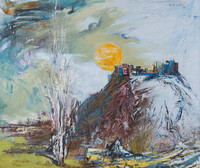
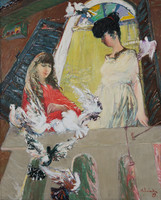
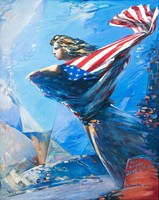
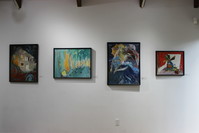
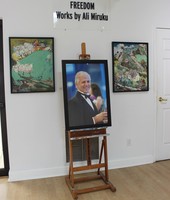
An exhibit at the Cultural Center at Ponte Vedra Beach features the paintings of an artist and Ponte Vedra resident who grew up in Albania and witnessed the upheaval in Eastern Europe when the Iron Curtain fell and the region struggled to adopt a democratic system.
Titled “Freedom,” the exhibit on display through Oct. 14 displays the works of the late Ali Miruku, who escaped the communist regime of his native Albania and immigrated to the United States. In 1994, he moved to Ponte Vedra Beach, where he was later joined by his wife, son and daughter, Arjola Miruku, a classical pianist and instructor at the cultural center.
“We were really excited to get this exhibition,” said Leigh Rodante, director of programs and exhibitions. “(Miruku) was one of only 10 artists commissioned to paint under the communist regime, so it’s important to us to showcase to work.”
As one of the few painters who was allowed to paint during the communist regime, Rodante said, Miruku had to depict what the regime wanted him to paint, in the only style of painting that was allowed – realism. After he escaped to America, however, he was free to paint what he desired and express the turmoil he had experienced under the oppression.
Of the 25 paintings on display, “The Bride of Kosovo,” painted in 1987, still depicts the realist style, but includes slight transition to a new, more impressionist style. The rest of the paintings on display range from 1989 to 1993 and represent Miruku’s post-communism impressionistic work.
Originally to be titled “Retrospective,” the exhibition’s name was changed after it was decided that “Freedom” would be a more apt name, since the paintings represent the first time that Miruku was free to paint whatever and however he desired. Two recent works, for example, are titled “United We Stand” and “American Compassion.” His daughter, Arjola Miruku, noted that only two of her father’s works, “April 2nd, 1991” and “United We Stand,” have words on the painting and both were created in response to tragedies. April 2, 1991 marks a tragic moment in Albanian history when four young students were killed in demonstrations to promote democracy. The second painting marks the September 11 attack.
Arjola Miruku noted that the turmoil in Albania parallels the conflict in Syria.
“This why it’s important to preserve and promote these stories because they’re relevant, they’re parallel to what’s happening now,” Miruku said. “I can’t even listen to Syria and what’s happening in the news. I have to turn NPR off because I cry and it all comes back – the gunshots the drownings, the people. It’s always happening somewhere and an artist is creating something there too, that’s the way they experience the world.”
Another painting, “The Sea and I,” portrays a feeling of chaos, but it also includes imagery that represents hope.
“That’s when he tried to leave the country to immigrate to find a better life for his family and so that’s the ocean and the turmoil and the chaos that’s happening,” she said. “The green light, he would always tell me, that’s the hope. He would say, ‘I have hope that something is out there somewhere.’”
“Freedom” is on display in the Scene Gallery through Oct. 14. Gallery hours are Monday-Friday from 3 to 5 p.m. and Saturday from 10 a.m. to 11 a.m. and 2 to 4 p.m. The gallery is closed daily from 11 a.m. to 2 p.m. for open studio. After hours appointments are available.
The Cultural Center is located at 50 Executive Way. For more information, call (904) 280-0614 or visit www.ccpvb.org.